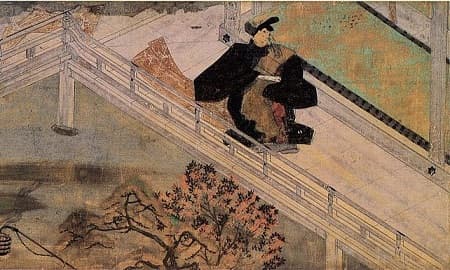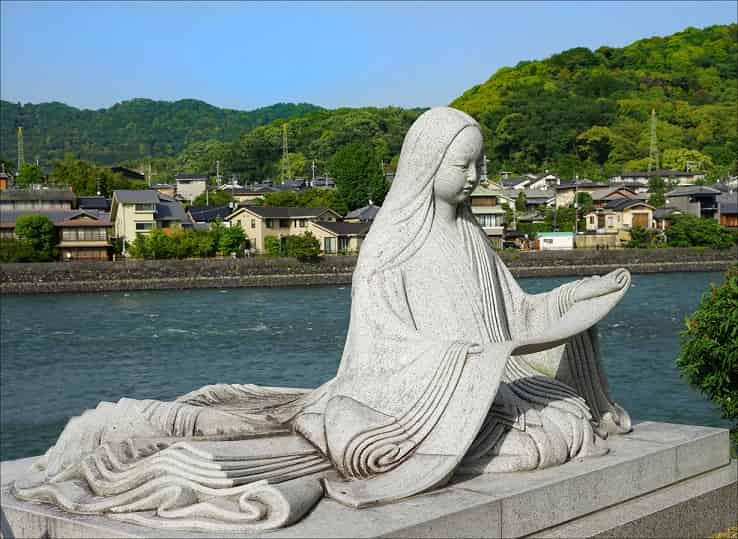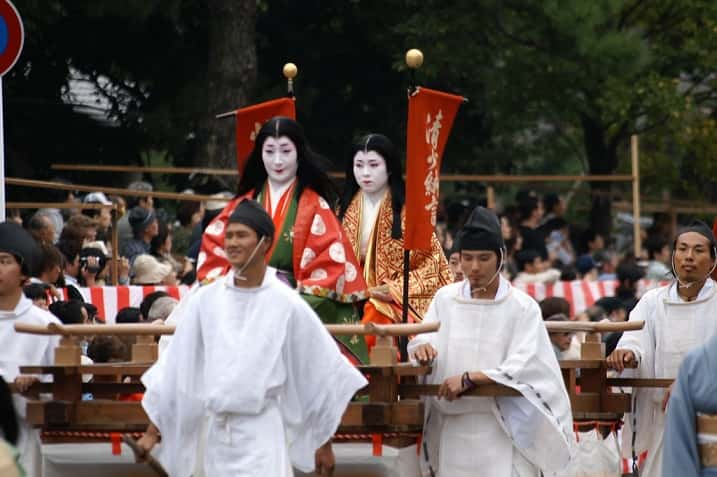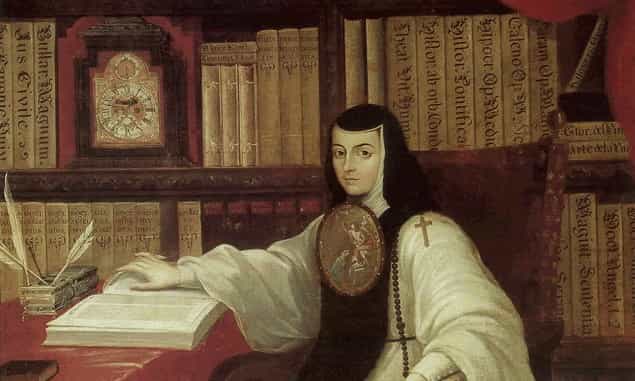These six women left their mark in World Literature.
They wrote centuries ago, during the Middle Ages and the Baroque. Yet, they remain widely read.
And by now, they have achieved iconic status in their countries and regions.
Here are six great female authors from around the world:
Kassia. Byzantium (Turkey), c. 810 – 860.
Kassia was born in Constantinople more than a thousand years ago.
Kasisa always wanted to be a nun, since she was a child.
She was also brainy and a good writer since she was young. We know that through three surviving letters that Theodore the Studite wrote to her when she was a teenager.
In one of the letters, the erudite praises Kassia for her devotion and good works -she had defended an imprisoned monk. In other letters, it is Kassia’s writing style that earns his praise.
Kassia, the almost empress of Constantinople
In 823, the mother of co-emperor Theophilos thought it was time for him to get married. Theophilos was a teenager, but since he was the co-emperor of the Roman Empire, it was a good idea he had an heir.
So, foreshadowing the Cinderella story, Theophilos’ mother invited the most eligible and beautiful maidens of the realm to meet him.
Kassia’s father was a high-born military officer who served at the Imperial Court, thus, Kassia was invited.
Once at the ball, it was Theophilos’ turn to pick his future wife. The young emperor narrowed his choice down to two: Kassia and another beauty called Theodora of Paphlagonia.
His mother had provided Theophilos with a golden apple that he was to give to his bride.
The young co-emperor walked over to beautiful Kassia, apple in hand, and said: “Through woman trickled forth the baser things.” But then the girl replied: “But also through woman gush forth the better things.”
Apparently, Theophilos was not a fan of witty retorts. He turned away and gave the apple to Theodora instead.
The anecdote first appears in the chronicles of Symeon the Logothete, written in the 10th century.
Kassia’s works and sainthood
After her dismissal, Kassia went on to fulfill her childhood dream: she became a nun.
Like other aristocratic ladies, she founded her own monastery and became the abbess.
There she kept writing and philosophizing. The dichotomy of evil-good woman that showed up in her conversation with the emperor kept appearing in her writings.
Kassia believed humans were sinful, but she also believed in contrition and redemption.
This great Medieval writer penned poems and hymns. And she composed the music for her hymns.
In the 14th century, Nikephoros Kallistos Xanthopoulos considered her the 11th most influential composer in the history of the Church.
There are 49 hymns believed to be hers. Scholars are sure that at least 23 of them were truly written and composed by Kassia.
One of them, Hymn of Kassiana, is still part of the official Byzantine rituals. It is sung on Holy Wednesday, and many Orthodox churchgoers think of it as the most moving of songs.
Nowadays, the Eastern Orthodox Church considers Kassia a saint. She is celebrated on September 7. And her image adorns many Orthodox churches.
Murasaki Shikibu. Japan, c. 973 – 1014.
Muraski wrote The Tale of Genji, which some consider to be the first novel ever written. Since the title of ‘first’ tends to draw contenders, others settle for calling it the first modern novel.
In any case, most agree that it is one of the finest works in World Literature and Japan’s best.
Murasaki’s novel

The Tale of Genji takes place a thousand years ago in the Imperial Court. It follows the love life of Prince Genji, who is the favorite son of the Emperor.
But Genji was born out of wedlock, so as much as his father loves him, he cannot name him his successor. Instead, he names one of his legitimate sons as his heir. And to protect Genji from intrigues, he strips Genji from all royal titles.
Genji falls in love with three forbidden women. First, with his stepmother, then, with a young girl. And finally, with the mistress of his brother, who is now emperor.
The beautifully written long novel keeps a slow pace as it explores the inner world of its characters and portrays life at court, with its traditions, conflicts, and vanities.
Although it is fictional, scholars believe the main characters -there are more than 400 in total- are based on real people. Some of them, the author, Murasaki, would have met in court. Murasaki was a lady-in-waiting for Empress Shoshi.
The author, Murasaki
Murasaki belonged to the powerful Fujiwara family that, at the time, governed Japan.
Her father was a provincial governor and a scholar. And her great-grandfather was the renowned poet Fujiwara no Kanesuke (877-933).
Murasaki herself received quite an education. She even learned Chinese. Only Japanese noblemen were supposed to know that cultured language. But the transgression allowed Murasaki to read Chinese literature and poetry.
This great writer was born around 973 in Kyoto, in her father’s house, which stood next to the Imperial Palace.
When she was a teen, her father was named governor of Echizen. So Murasaki went with him to the province, and they lived there for several years.
In 998, she married an older relative, Fujiwara Nobutaka, who died three years later. Presumably, Murasaki started writing The Tale of Genji after his death.
Five years into widowhood, Murasaki was called to the Imperial court to serve the empress as her lady-in-waiting.
Murasaki probably kept polishing her novel while in court.
Some of Murasaki’s poems have also survived, along with a diary she kept during her first two years in court. In her diary, she writes about the superficiality of court life.
Yet her lasting fame comes through her novel.
Heloise d’Argenteuil. France, c. 1098 – 1164.
Heloise’s love correspondence with her lover Abelard inspired the likes of Alexander Pope, Rousseau, and Mark Twain.
Moving to Paris

Heloise was born in France at the end of the 11th century.
As a girl, she attended a convent in Argenteuil, where she learned Latin, Greek, Hebrew, and the Classics.
When Heloise was about 19, she went to live with her uncle Fulbert in Paris. The uncle was a respected man and a canon of the cathedral St. Etienne (nowadays called Notre-Dame).
And Fulbert was proud of his niece’s well-known intellectual achievements.
But soon, someone else took an interest in the girl prodigy: Peter Abelard. Abelard was considered the best philosopher and intellectual in Paris. He was in his thirties.
Abelard had heard of Heloise’s intellectual reputation. And, according to his own account, after seeing the beautiful girl, he fell madly in love.
After that, he, who until then had only been interested in scholarly pursuits, did everything in his power to get close to the girl.
Since he, too, worked for the Church, teaching philosophy, he befriended Fulbert, Heloise’s uncle.
Then, Abelard convinced Fulbert to rent him a room in his own house, where Heloise lived.
And when unsuspecting Fulbert asked Abelard to please teach philosophy to his niece, the young scholar happily accepted.
Scandal and crime
For two years Abelard and Heloise carried on a secret relationship in her uncle’s house.
Abelard wrote that he could not think of philosophy anymore, that all he could write were love poems.
Fatefully, his students started circulating those poems around Paris.

The secret is out. And Parisians start gossiping about the relationship between Heloise and Abelard.
Fulbert hears the gossip and evicts Abelard from his home. But it was late, Heloise was pregnant.
She notifies her lover of the pregnancy. He helps her escape and sends her to Brittany, where Heloise has the baby.
Abelard tries to appease Fulbert by marrying Heloise. He was not a priest, but he could not marry without losing his teaching position at the church. So he marries her secretly.
The marriage does appease Fulbert a little. But then a mistake: Heloise vehemently denies being married to protect Abelard’s job. Fulbert does not know what or who to believe anymore.
By then, medieval Paris is scandalized by the affair, by the escape, and by the baby. And knows nothing of the secret marriage.
Fulbert has had enough and takes his revenge. He hires a criminal that sneaks into Abelard’s house at night and castrates him with a knife.
Heloise and Abelard take religious vows
In the aftermath, both Heloise and Abelard renounce the world and go into monasteries.
For twelve years they lose contact. Then they start corresponding.
The first letters are full of passion on both sides, admitting that they are still in love. The next ones are more measured as they both believe their love to be sinful and that their energies should be directed towards the spiritual life they have chosen. In the last ones, they are quite prudent, intent on not tempting the other, and they mostly speak of philosophy, theology, and the adequate rules for monastic life.
Li Qingzhao. China, 1084 – c. 1155.

During the Tang and Song dynasties, educated Chinese were expected to compose poetry and share it at social events.
Most women composed their verses in a poetry form called ci. But Li Qingzhao outdid them all.
Li’s verses are considered among the finest ever written in ci. Her writing is elegant and original, full of metaphors that create vivid pictures for the reader.
Her poetry deals with personal feelings, so it easily connects with people across time.
Li is considered China’s greatest poetess. Her work has been inspiring both poets and romantics for the last 1,000 years.
The many interests of a great writer
Li is not only a master of the ci form; she also wrote widely admired shi poems (a highly regulated type of poetry).
Furthermore, the noblewoman penned one of the earliest theoretical writings on ci and an introduction for her husband’s book on art collecting.
Li was a History and Classics scholar, as well as a calligrapher.
Life of Li Qingzhao
The poetess was born in 1084 in Jinan, province of Shandong, to a literary family that worked for the Imperial court.
Both of her parents wrote poetry, so Li was already writing verses as a teenager.
At 17, she married Zhao Mingcheng, a 21-year-old scholar interested in the arts. If one is to judge by Li’s poems at the time, her marriage was a happy one, filled with laughter, love, and friends, which they challenged to poetry competitions.
But in 1126, the Jurchen invaded China and captured the capital. Half a million Chinese fled to the south, including Li and her husband Zhao.
Then, another blow. Three years after the invasion, Zhao died of an illness while traveling to Hu Hou, where he had been appointed governor.
Li’s formerly joyous poems became full of grief: “lone . . . cold . . . pain . . . moan,” she wrote, along with: “When there is possession, there must be loss of possession; when there is a gathering together, there must be a scattering…”
For the rest of her life, this great female writer moved around China avoiding the conquering Jurchen.
She also penned political critiques to the “cowardice” of the ruling Song and their ineffectual attempts to stop the invasion.
Akka Mahadevi. India, c. 1130 – 1160.
While Heloise favored mortal love over divine love, Mahadevi held the opposite view.
Mahadevi was in love with the Divine and scorned mortal love: “Take these husbands who die and decay,” she wrote, and, “More and more I am in love with my husband known by the name of Chennamallikarjuna (God).”
Akka Mahadevi is married to Shiva.. or to the king?

Mahadevi was born around 1130 in Karnataka, India.
When she was about 10, her family introduced her to the worship of Shiva (a name for God). By her teens, she had decided to dedicate her life to Shiva.
Legend says, although not all scholars agree, that the local ruler Kausika chose her to be his wife because he was dazzled by her beauty. Supposedly, she accepted under the condition that the marriage was not to be consummated, ever. The king agreed, but after a while, he could not keep his side of the deal.
Mahadevi abandoned the palace. And as she was leaving, scorned Kausika demanded she returned all the jewels and clothing he had given her. She obliged. And walked out of the palace naked.
Life of a wandering saint
Whether the royal marriage took place or not, Mahadevi did become a wandering saint that, following an ascetic tradition of India, walked around naked, only covered by her long hair.
She walked from place to place singing her poems until she reached Anubhava Mantapa, a gathering place for mystics and philosophers. There, discussions on the equality of all humans, spirituality, and other subjects were held.
After questioning her for a long time, the head of the academy recognized her wisdom and purity of thought and accepted her as part of the group. They gave her the title of Akka (“sister”).
Eventually, she left the academy and continued to wander.
Apparently, she spent the last years of her life in a cave. There she attained enlightenment, the goal she had been after for ages.
Akka Mahadevi’s legacy
Akka Mahadevi’s poems are full of love for the Divine, like the poems of other mystics such as Rumi (Sufi, 13th century) and St. Teresa of Avila (Catholic, 16th century).
“I am in love with the one / Who knows no death, no evil, no form. / I am in love with the one / Who knows no place, no space, / no beginning, no end,” wrote Mahadevi.
She left some 430 vachanas (a type of poem) that are read to this day. Those vachanas, along with two of her short writings, are considered some of the best pieces of Kannada-language literature.
Today, she is considered a social reformer and is worshiped as a saint in India.
Sor Juana Ines de la Cruz. New Spain (Mexico), c. 1651 – 1695.

Juana Ines de la Cruz is one of the great voices in Spanish-language literature.
She could easily pen a play, a sonnet, romance, dissertation, or a carol. She could write about religious or profane subjects. Juana could be funny or serious, write in prose or verse, with erudition or with stripped-down language for popular consumption.
And this woman was a prolific writer: a modern compilation of her work fills four volumes.
But her most famous works are the poem Foolish men and a rebuttal called Reply to Sister Filotea. In Foolish men, she uses logic and wit to turn the tables and blame men for which, she believes, men usually blame women. Needless to say, it is a poem that modern feminists tend to like.
Lady-in-waiting
Juana was born in what is now Mexico, but that in those colonial times was called the Viceroyalty of New Spain.
Her father was a Spanish captain. And her mother was a Criolla, that is, someone of Spanish blood born in the Americas.
Juana was precocious: at three, she learned to read; at eight, she wrote her first piece.
Growing up, she lived in her maternal grandfather’s plantations and spent most of her time reading in his library.
When she was eight (in 1659), she went to live with her aunt in the capital. There she learned Latin and became known for her intellect.
Eventually, the Vicereine Leonor Carreto, marquise of Mancera, heard about the girl and asked the 14-year-old to be her lady-in-waiting.
Juana, witty and charming, was a hit in court. She was supposed to find a husband there, but due to what she called her “total disinclination to marriage” and her love of knowledge, at twenty she decided to become a nun instead. She figured that as a nun she would have free time to study.
Sor Juana, the intellectual nun
Juana lived in the convent of St. Paula in Mexico City. She taught music and drama to the girls that attended Saint Paula’s school.
She had a spacious apartment for herself. And her private library was one of the largest in the Americas at the time.
In her rooms, she received friends from court, including intellectuals and her protectors, the new viceroy Tomás de la Cerda, marquis of Laguna, and his wife Luisa Manrique de Lara, countess of Paredes.
Although the great writer did not leave the convent, she remained an unofficial poet of the court. She wrote plays, poems, and all sorts of works for her maecenas.
The viceroy and his wife published her work in Spain, where it was met with great success.
Juana’s defense of knowledge and legacy
After her protectors, the viceroy and his wife, returned to Spain in 1688, Juana was attacked by Church officials for her lack of religious zeal.
The bishop of Puebla published an open letter addressed to her, under the pen name Sor Filotea (“Sister Filotea”), urging her to shy away from mundane knowledge.
Juana’s reply to the letter is a rigorous argument that defends a woman’s right to knowledge and defends learning as a path to reach God.
Juana Ines de la Cruz is considered the first great poet of the Americas.
She remains widely read in Spanish-speaking countries. And in Mexico, Juana is a national icon.
Related Articles














